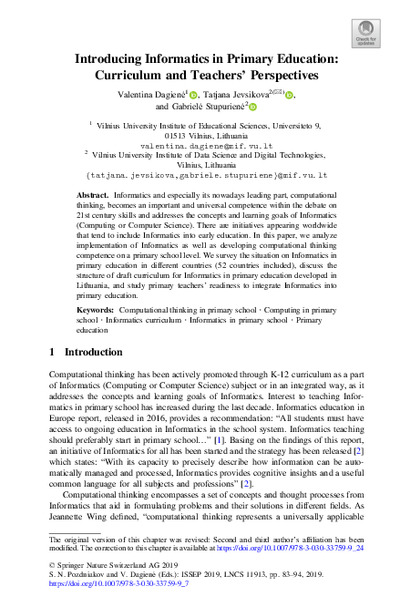Introducing Informatics in Primary Education: Curriculum and Teachers’ Perspectives |
 |
 Diese Seite wurde seit 1 Jahr inhaltlich nicht mehr aktualisiert.
Unter Umständen ist sie nicht mehr aktuell.
Diese Seite wurde seit 1 Jahr inhaltlich nicht mehr aktualisiert.
Unter Umständen ist sie nicht mehr aktuell.
 Zusammenfassungen
Zusammenfassungen
 Informatics and especially its nowadays leading part, computational thinking, becomes an important and universal competence within the debate on 21st century skills and addresses the concepts and learning goals of Informatics (Computing or Computer Science). There are initiatives appearing worldwide that tend to include Informatics into early education. In this paper, we analyze implementation of Informatics as well as developing computational thinking competence on a primary school level. We survey the situation on Informatics in primary education in different countries (52 countries included), discuss the structure of draft curriculum for Informatics in primary education developed in Lithuania, and study primary teachers’ readiness to integrate Informatics into primary education.
Informatics and especially its nowadays leading part, computational thinking, becomes an important and universal competence within the debate on 21st century skills and addresses the concepts and learning goals of Informatics (Computing or Computer Science). There are initiatives appearing worldwide that tend to include Informatics into early education. In this paper, we analyze implementation of Informatics as well as developing computational thinking competence on a primary school level. We survey the situation on Informatics in primary education in different countries (52 countries included), discuss the structure of draft curriculum for Informatics in primary education developed in Lithuania, and study primary teachers’ readiness to integrate Informatics into primary education. Dieses Konferenz-Paper erwähnt ...
Dieses Konferenz-Paper erwähnt ...
 Begriffe KB IB clear | computational thinkingcomputational thinking
, Informatikcomputer science
,  Primarschule (1-6) / Grundschule (1-4) Primarschule (1-6) / Grundschule (1-4) primary school primary school
|
 Dieses Konferenz-Paper erwähnt vermutlich nicht ...
Dieses Konferenz-Paper erwähnt vermutlich nicht ... 
 Nicht erwähnte Begriffe | Informatik-Didaktik, Informatik-Unterricht (Fachinformatik) |
 Anderswo finden
Anderswo finden
 Volltext dieses Dokuments
Volltext dieses Dokuments
 |  Introducing Informatics in Primary Education: Curriculum and Teachers’ Perspectives: Artikel als Volltext @ Springer ( Introducing Informatics in Primary Education: Curriculum and Teachers’ Perspectives: Artikel als Volltext @ Springer ( : :  , 776 kByte; , 776 kByte;  : :  ) ) |
 Anderswo suchen
Anderswo suchen 
 Beat und dieses Konferenz-Paper
Beat und dieses Konferenz-Paper
Beat hat Dieses Konferenz-Paper während seiner Zeit am Institut für Medien und Schule (IMS) ins Biblionetz aufgenommen. Er hat Dieses Konferenz-Paper einmalig erfasst und bisher nicht mehr bearbeitet. Beat besitzt kein physisches, aber ein digitales Exemplar. Eine digitale Version ist auf dem Internet verfügbar (s.o.). Aufgrund der wenigen Einträge im Biblionetz scheint er es nicht wirklich gelesen zu haben. Es gibt bisher auch nur wenige Objekte im Biblionetz, die dieses Werk zitieren.










 Biblionetz-History
Biblionetz-History